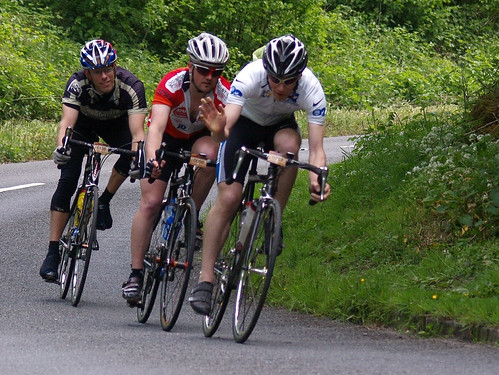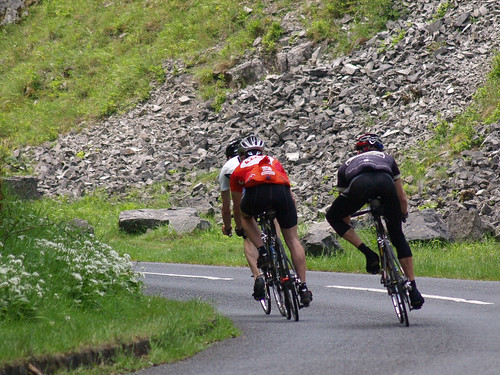
Cycle sportives are one of the fastest growing areas of cycling. They provide one day challenges of both distance and climbing. Some of the hardest cycle sportives can be as difficult and demanding as a stage of the Tour de France. Many who are wanting to ride a 200km plus cycle sportive will be anxious to consider the best way of training for a 200km ride, especially as most people have limited time to train.
Building up Base Endurance
For many sportive riders, one of the challenges is getting use to riding the distance. Sportives over 100 miles definitely need careful preparation and you need to work up to the mileage you are comfortable with. Some quick tips for building up base endurance.
- Don’t leave it to last few weeks before trying to acclimatise to 100 mile rides. Start planning ahead, build up mileage in incremental increases, e.g. weekly total of 10%
- Look for opportunities to get more miles in, e.g. commuting to work by bike, cycling to the shops.
- With longer distance riding, it is important to pay attention to cycle nutrition and energy requirements. See: Tips for cycle nutrition
See: Tips for long distance riding.

photo M.J.S. Flickr
Weekly longer Ride.
Once a week, it is necessary to find time for a longer ride. This doesn’t have to be 4-6 hours every week of the year. One good tip is to try every month to get a good distance ride in. This monthly ride should try to by 70-80% of the target ride. So if you are planning to do a 200Km ride, it is good to aim to have done at least, a 150km ride in training. But, a long ride once a month, will be sufficient for making you used to riding the longer miles. Obviously, if you can do it more frequently, that is better, but, it is not essential to cycle 300 miles every week.
Quality of Miles – Threshold Training
For the other rides during the week, it is important to give priority to quality training sessions. In these sessions, the aim is to improve and stretch your fitness; it is training that will make you able to ride faster. If you can ride faster at 10 miles, you will be able to ride faster for 100 miles. Just riding a bike at a comfortable pace, doesn’t really improve your fitness. What will improve your aerobic fitness is training at or near your anaerobic threshold. (see: Threshold Training) This training should be ‘comfortably hard’. Training at this intensity will increase your aerobic capacity and enable noticeable improvements in your overall fitness levels. This will give you greater ability to ride up hills in the sportive challenge.
- The day after a tough threshold training, it is good to have an easy day. Either a day off the bike, or cycling at low intensity. A long steady ride can interrupt recovery. However, threshold training does less damage than anearobic efforts. With 20 minutes ‘threshold training’ you can make big strides in fitness.
Hill Sprints.
Another good training sessions is to ride fast up hills at a pace, even higher than your lactate threshold; a pace higher than you could maintain for an hour. These will improve your fitness and power.
Shifting your training from ‘easy’ base training to shorter higher intensity efforts will lead to improved performance in many areas:
- Increased blood plasma volume
- Higher performance of fast twitch fibres
- Accumulate lactate at a higher % of VO2 max
- Increased ability to ride quickly.
In short don’t be deterred from entering cycle sportives, even if you can’t commit to a lengthy training schedule. The important thing is to make the most of your limited training time and give focus to your training efforts.
It means some of these intense efforts should be done on your own. Riding in a group often leads to slow moderate efforts, the kind of riding that doesn’t do much to improve your fitness.
If you enjoy comfortable riding and you have the time to ride all day, it will be of some help. But, to make the fastest improvement, it is important to stretch your ability; this means riding out of your comfort zone.
Training for Multiday Sportive
Some multiday events offer three consecutive days of riding. For example. 106miles, 117 miles & 106 miles.
With a one day sportive, you can always grovel around and if your legs ache the next day, it doesn’t matter – you can take as long as you want to recover. But, with a three day, it is even more important you are used to the distance, and also used to riding consecutive days.
If I was training for this kind of sportive, it would mean some big weekends of training. I would want to be doing say 100 miles on Saturday and at least another 50 miles on Sunday.
Target of Training Miles. For this kind of distance, I would want to be comfortable with riding 300 miles in a week. It doesn’t mean you have to do 300 miles every week. But, perhaps once a month, you would want a week with at least 300 miles +. If you can do more training, even better, but, this would be a rough rule of thumb.
Building up the Miles
A key issue in this training is simply building up the miles. If you currently cycle say 100 miles a week, you need to target a steady increase in weekly mileage. A training plan like this gives an idea of how you can gradually build up distance. But, there are no hard and fast rules, you have to listen to the body and see how quickly you can progress.
- Week 1 – 120 miles
- Week 2 - 150 miles
- Week 3 – 180 miles
- Week 4 – 120 miles (easier week)
- Week 5 – 200 miles
- Week 6 – 120 miles (easier week)
- Week 7 – 220 miles
Riding A Multiday Sportive
When you are reasonably fit, another big challenge of a multiday is actually riding it and getting sufficient energy. Remember the motto of the pros – you are eating for the next day.
Riding a Cyclo Sportive
Once you’ve done the training, you will be eager to start riding. There’s a few tips here on how to ride a cyclo sportive.
In particular, a key feature is getting nutrition and hydration correct. If you get it wrong (and it’s surprisingly easy) you will end up feeling uncomfortable or sick.
See: Tips on Riding a Cyclo Sportive
Books on Cycle Sportive Training
Elite Performance: Cycling: Successful Sportives by Garry Palmer and, Richard Allen. Comes with good reviews from Amazon.co.uk
Related Books on Cycle Training
Serious Cycle Training at Amazon.co.uk
Cyclist’s Training Bible – Joe Friel
More Articles on Training
More articles on Cycling
- UK Cyclo Sportives
- Photo by Tricky (a sportive in Scotland)
- Principles of cycle training





I hope you don’t mind but I have a somewhat daft question I did one sportive last year to see if I enjoy it, I did so I have stopped running (due to my knees) and taken up cycling and love it lots of exercise no pain, I’m currently on a training program using the books you suggested (above).
I have used a formula and carried out a test and at the moment my lactate threshold is 152bpm, it may be a coincidence but the formula and Conconi Test came out exactly the same.
Now I’m not a scientist and there is a minefield of information out there, however I presume if I continue my training program my Lactate threshold should improve. So just before my sportive season starts I will test again and see if I have, actually improved.
Here is the daft question. I can not find the answer anywhere and as a beginner its bugging me. Here Goes……..When I actually do the sportives, how fast should I go?
if I try and stay just under my Lactate Threshold 152 (or new Lactate threshold) I should complete the course. I’m worried if I go faster I may run the risk of not making the distance.
in saying that what’s the point in spending months training if you don’t go out and give 110% and thrash it round as quick as possible.
To be perfectly honest I’m training because everyone says you must, I have picked my main goal all my mini goals I’m working hard, I’m learning bike maintenance and so on.
So, am I training to improve my Lactate Threshold which in turn will get me round the course (even quicker), or am I training to try and do the course as quick as possible?
You see I told you it was daft, however thank you at least for reading it any help will be greatly appreciated and thanks for taking the time to help beginners like myself.
Lee
iam about to start training for a 67 mile charity bike event for help for heros can anybody give me some tips for a training calander up to the date which is in may 2011 may thanks.
Hi folks
Great tips here thanks. Am looking to do my first sportive in May at Drumlanrig Castle, Dumfries. The full length is 82 miles with a single loop at 41miles. I figure i’ll train for the full distance and see how I feel on the day.
Cheers